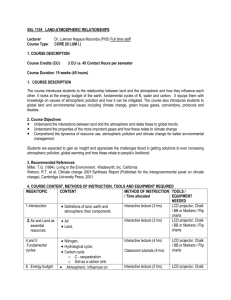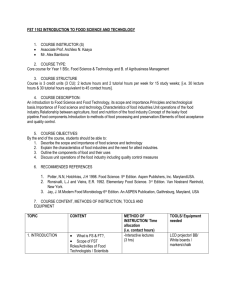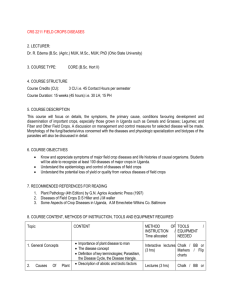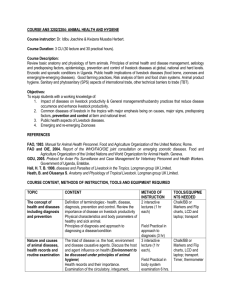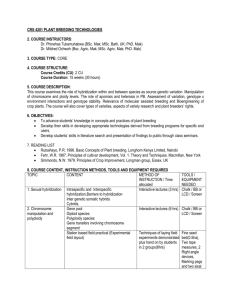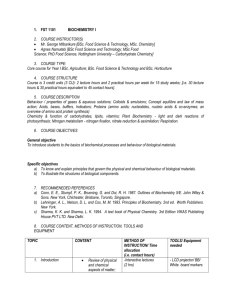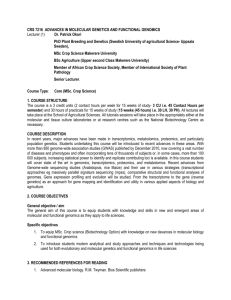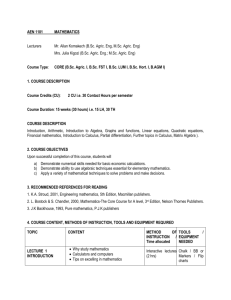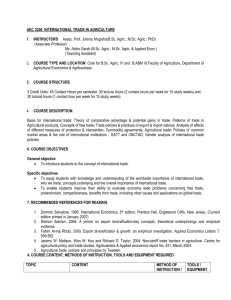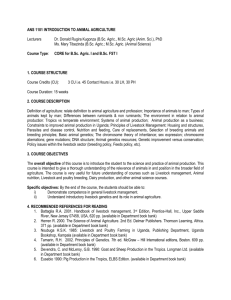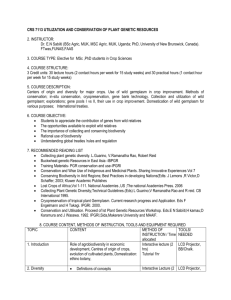SOS 7105 MUNICIPAL AND FARM ORGANIC WASTES AND
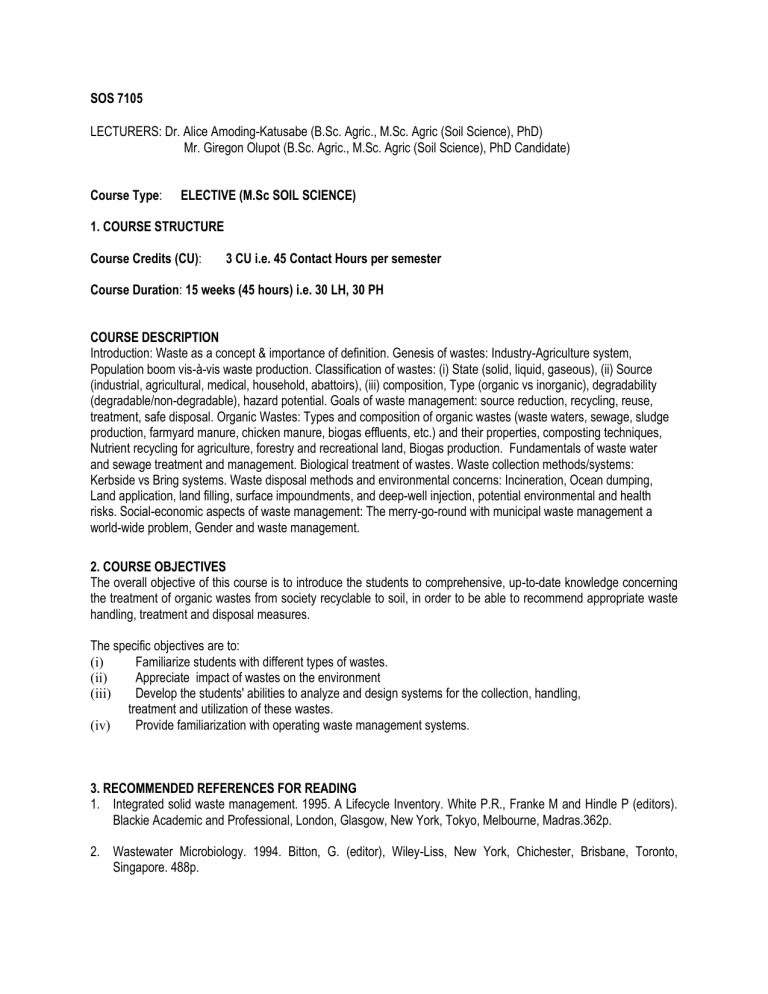
SOS 7105
LECTURERS: Dr. Alice Amoding-Katusabe (B.Sc. Agric., M.Sc. Agric (Soil Science), PhD)
Mr. Giregon Olupot (B.Sc. Agric., M.Sc. Agric (Soil Science), PhD Candidate)
Course Type: ELECTIVE (M.Sc SOIL SCIENCE)
1. COURSE STRUCTURE
Course Credits (CU): 3 CU i.e. 45 Contact Hours per semester
Course Duration: 15 weeks (45 hours) i.e. 30 LH, 30 PH
COURSE DESCRIPTION
Introduction: Waste as a concept & importance of definition. Genesis of wastes: Industry-Agriculture system,
Population boom vis-à-vis waste production. Classification of wastes: (i) State (solid, liquid, gaseous), (ii) Source
(industrial, agricultural, medical, household, abattoirs), (iii) composition, Type (organic vs inorganic), degradability
(degradable/non-degradable), hazard potential. Goals of waste management: source reduction, recycling, reuse, treatment, safe disposal. Organic Wastes: Types and composition of organic wastes (waste waters, sewage, sludge production, farmyard manure, chicken manure, biogas effluents, etc.) and their properties, composting techniques,
Nutrient recycling for agriculture, forestry and recreational land, Biogas production. Fundamentals of waste water and sewage treatment and management. Biological treatment of wastes. Waste collection methods/systems:
Kerbside vs Bring systems. Waste disposal methods and environmental concerns: Incineration, Ocean dumping,
Land application, land filling, surface impoundments, and deep-well injection, potential environmental and health risks. Social-economic aspects of waste management: The merry-go-round with municipal waste management a world-wide problem, Gender and waste management.
2. COURSE OBJECTIVES
The overall objective of this course is to introduce the students to comprehensive, up-to-date knowledge concerning the treatment of organic wastes from society recyclable to soil, in order to be able to recommend appropriate waste handling, treatment and disposal measures.
The specific objectives are to:
Familiarize students with different types of wastes.
(i)
(ii)
Appreciate impact of wastes on the environment
(iii)
Develop the students' abilities to analyze and design systems for the collection, handling,
treatment and utilization of these wastes.
(iv)
Provide familiarization with operating waste management systems.
3. RECOMMENDED REFERENCES FOR READING
1.
Integrated solid waste management. 1995. A Lifecycle Inventory. White P.R., Franke M and Hindle P (editors).
Blackie Academic and Professional, London, Glasgow, New York, Tokyo, Melbourne, Madras.362p.
2.
Wastewater Microbiology. 1994. Bitton, G. (editor), Wiley-Liss, New York, Chichester, Brisbane, Toronto,
Singapore. 488p.
3.
Wastewater Microbiology. 2005. Bitton, G. (editor), 3rd. Edition. Wiley-Liss, New York, Chichester, Brisbane,
Toronto, Singapore. John Wiley & Sons, Inc. 746p.
4.
Microbiology of Landfill sites. 1990. Senior E (editor), Boca Raton, Fla. CRC Press. 220p.
5.
Systems and Markets Overview of Anaerobic Digestion. 1997. IEA Bioenergy. 20p
6.
The Science of Composting. 1997. Epstein E. Technomic Publishing Co., Inc., Lancaster, Pennsylvania, U.S.A.
487p.
7.
Toxic Metals in Soil-Plant Systems. 1994. Ross S M (editor), John Wiley and sons, Chicester, New York,
Brisbane, Toronto, Singapore. 469p
8.
Hygienic aspects of organic waste use in Agriculture. 1999. Albihn, A. In: Petersen J and Petersen S.O. (eds).
Use of municipal organic waste. Proceedings of the NFJ seminar no. 292. Nov 23-25, 1998, Jokioinen, Finland.
9.
Strategy to Improve Solid Waste Management in Kampala City. 2002. Programme Coordination Unit, Kampala
City Council. 25p.
10.
Journal articles on Organic pollutants in Sewage Sludge, Composting of organic household waste and other waste management aspects.
4. COURSE CONTENT, METHODS OF INSTRUCTION, TOOLS AND EQUIPMENT REQUIRED
TOPIC
1. INTRODUCTION
2. GENESIS OF
WASTES
3. CLASSIFICATION OF
WASTES:
CONTENT
Waste as a concept & Importance of definition.
Industry-Agriculture system.
Population boom vis-à-vis waste production.
METHOD OF
INSTRUCTION / Time allocated
Interactive lectures (2 hrs)
Interactive lectures (2 hrs)
Class assignment
Field excursion to Urban market (3 hrs)
Interactive lectures (2 hrs)
TOOLS /
EQUIPMENT
NEEDED
Chalk/BB or Markers/
Flip charts/LCD
Projector
Chalk/BB or Markers/
Flip charts/LCD
Projector
Chalk/BB or Markers/
Flip charts/LCD
Projector
4. GOALS OF WASTE
MANAGEMENT:
(i) State (solid, liquid, gaseous),
(ii) Source (industrial, agricultural, medical, household, abattoirs),
(iii) composition, Type (organic vs. inorganic), degradability
Source reduction, recycling, reuse, treatment, safe disposal
(degradable/non-degradable), hazard potential.
Interactive lectures (2 hrs)
Chalk/BB or Markers/
Flip charts/LCD
Projector
5. ORGANIC WASTES Types and composition of organic wastes (waste waters, sewage, sludge production, farmyard manure, chicken manure, biogas effluents, etc.) and their properties.
Interactive lectures (5 hrs)
Practicals (6 hrs)
Field excursions to
MUARIK (3 hrs)
Chalk/BB or Markers/
Flip charts/LCD
Projector
Transport
6. WASTE WATER
TREATMENT
7. BIOLOGICAL
TREATMENT OF
WASTES
8.WASTE COLLECTION
METHODS/SYSTEMS
9. WASTE DISPOSAL
METHODS
10. SOCIAL-ECONOMIC
ASPECTS OF
WASTE
MANAGEMENT
Composting techniques
Nutrient recycling for agriculture, forestry and recreational land.
Biogas production.
Fundamentals of waste water and sewage management. treatment and
Purpose
Methods (Trickling filters, Lagoons,
Activated sludge)
Biological hazardous waste treatment
Kerbside vs Bring and other systems
Collection Facilities – Skips, plastic bags, Refuse chutes,
Depots/refuse banks, The Garchey
system, Envac method
Distinguish between waste disposal and waste dumping:
Methods (Incineration, Ocean dumping, Land application, land filling, surface impoundments, and deep-well injection).
Potential environmental and health risks
The merry-go-round with municipal waste management a world-wide problem.
Gender and waste management.
Biogas plant (3 hrs)
Interactive lectures (4 hrs)
Field excursion to the
National water and
Sewerage Corporation
(3 hrs)
Interactive lectures (4 hrs)
Class assignment
Interactive lectures (3 hrs)
Interactive lectures (2 hrs)
5. SUMMARY OF TIME NEEDED
Interactive lectures covering theory 30 contact hours
Class based practicals and Field Excursions 30 practical hours
6. OVERALL COURSE EVALUATION
Continuous Assessment Tests/Take Home Exams 20%
Class practicals and Field work write-ups
Final examination
20%
60%
Interactive lectures (4 hrs)
Field excursion to
Landfill site (3 hrs)
Chalk/BB or Markers/
Flip charts/LCD
Projector
Transport
Chalk/BB or Markers/
Flip charts/LCD
Projector
Chalk/BB or Markers/
Flip charts/LCD
Projector
Chalk/BB or Markers/
Flip charts/LCD
Projector
Transport
Chalk/BB or Markers/
Flip charts/LCD
Projector
Transport
